The Committee on Design has reviewed the updated plans for 330 N Green Street in Fulton Market. Located just north of the intersection with W Wyman Street and replacing a vacant lot that was once the home of Coyne College, the mixed-use proposal is moving forward with a new taller and slimmer proposal we last covered in October. The Gensler-designed tower will be the third in the immediate area by developer Sterling Bay, with 360 N Green Street reaching its final height this week just to the north.
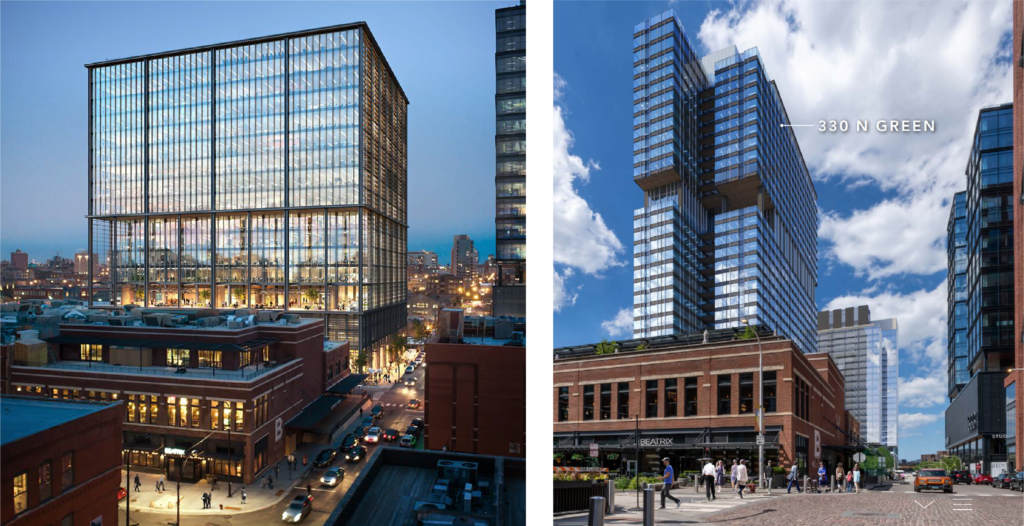
Comparison of previous (left) and updated (right) design for 330 N Green Street by SOM and Gensler
Having received a major redesign from its original iteration of the ‘The Porch’, the new proposal will now be the tallest of the trio and the first to break into skyscraper height. The change in plans was due to a change in demand from tech and business clients according to Sterling Bay in the committee presentation, the previous desire of large floor plates has given way to smaller, more tailor-made floors and outdoor space. The tower will now offer both after a handful of changes from its October proposal as well.
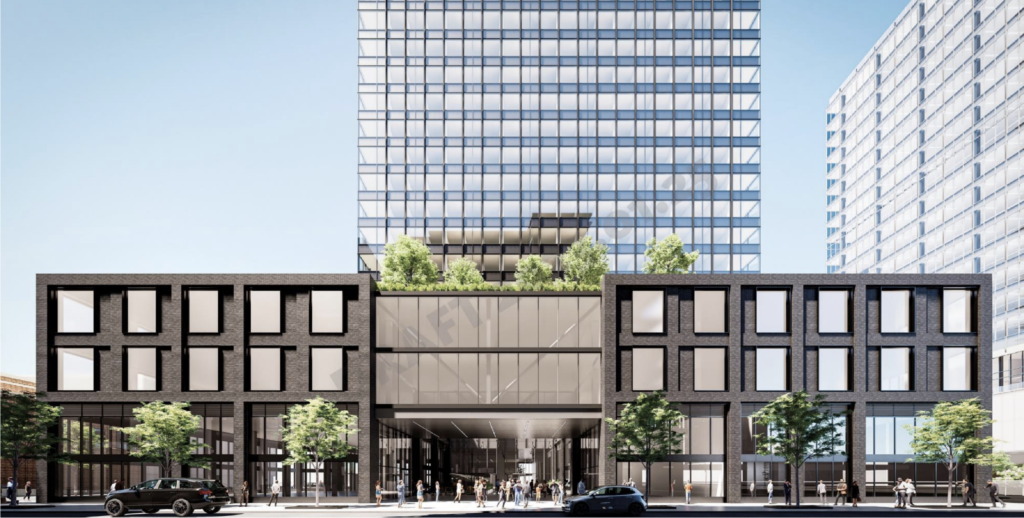
Rendering of podium of 330 N Green by Gensler
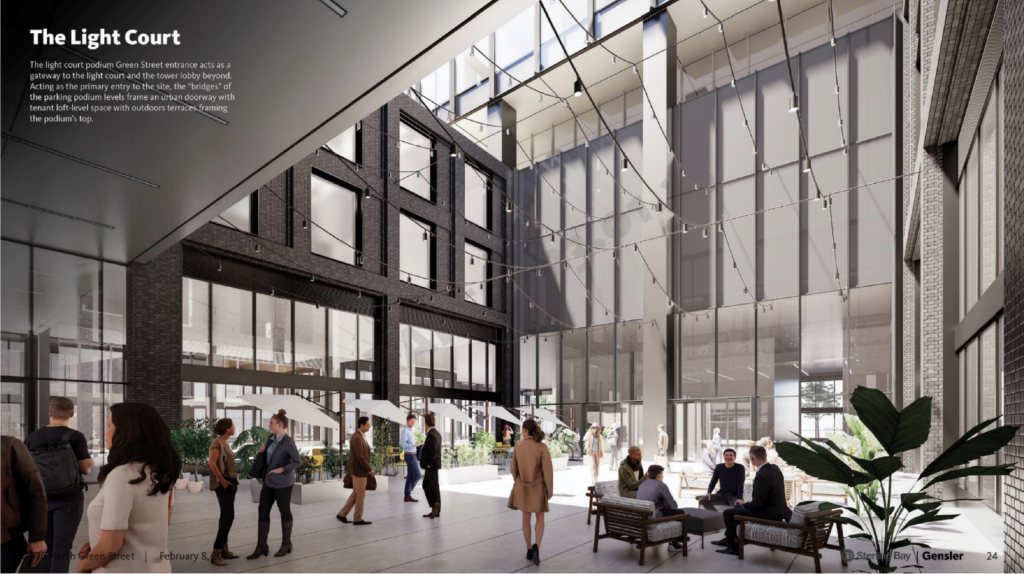
Rendering of light court by Gensler
Receiving a slight haircut from 35 stories, the development will now yield 33 stories and rise 503 feet tall. The five-story podium now drops to four while shedding the prairie-inspired top floor and deep inset vertical window bays. It will now deliver four floors of dark brick-clad space with storefront windows lining the first floor and punched openings on the remaining floors. However this ground level will still hold 13,650 square-feet of commercial space split into two, as they flank the central light court entered through an opening from the street and leading to the main lobby.
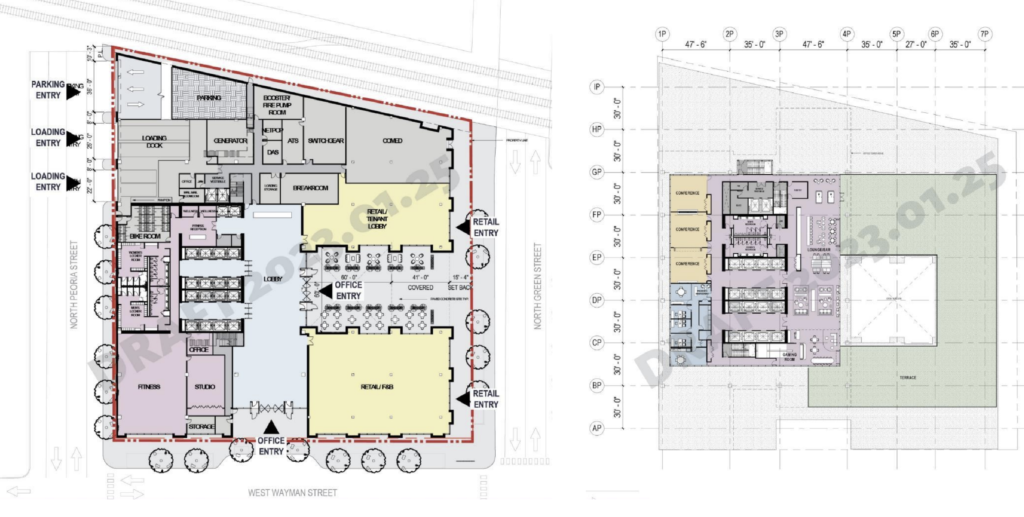
First (left) and fourth (right) floor plans of 330 N Green by Gensler
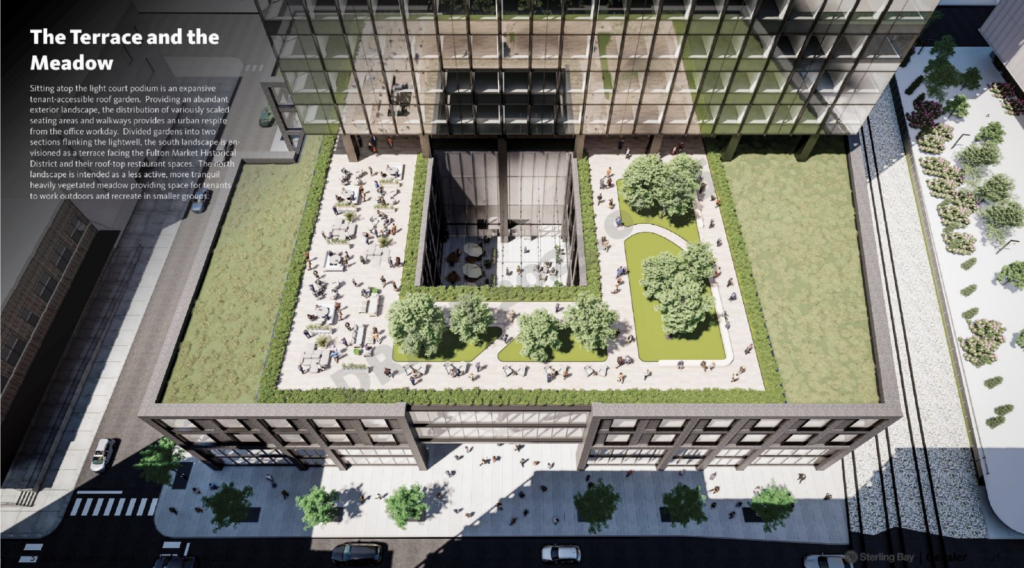
Rendering podium top deck and The Meadows by Gensler
The remainder of the podium will have a larger fitness center, 207-vehicle parking spaces, and a large fourth floor amenity space with a gaming room, lounge, and bar. This will open up to the rooftop terrace dubbed ‘The Meadow’, which had an outdoor pavilion removed in exchange for seating space and open grass space for relaxation. Above all this the tower itself will utilize a similar approach as 360 N Green Street, with the floor plans forming two separate column-free linear spaces tied together by the central core.
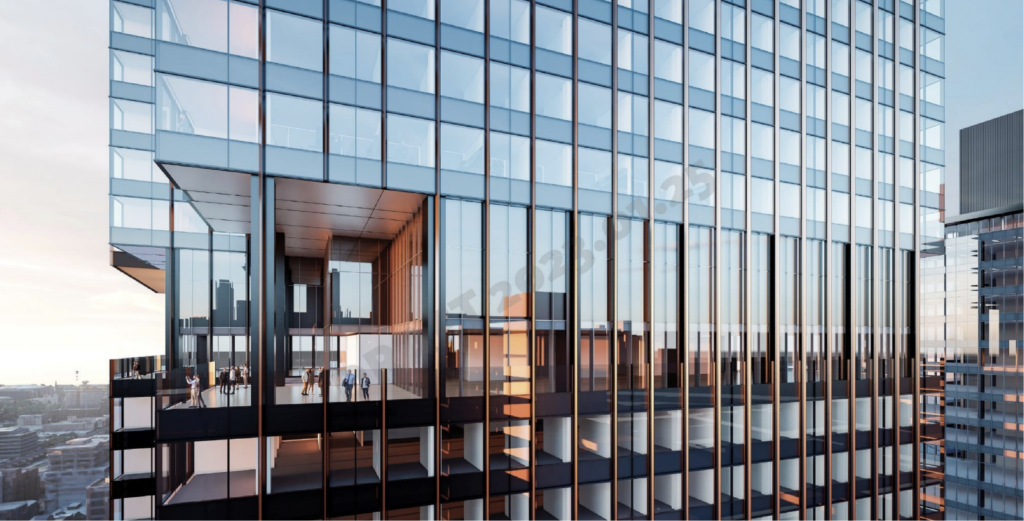
Rendering of 18th floor terrace by Gensler
This approach will allow for anchor tenants to have large floors with a separation, and for smaller companies to lease only half of a floor and still feel exclusive. Between the two sides will be a small terrace on each end allowing for all floors to have outdoor spaces, with larger ones on level 18 due to a mechanical floor above. As it rises, the easternmost portion of the tower terminates at the 30th floor, allowing for the final two penthouse levels to have an even larger rooftop deck facing towards the city.

Rendering and elevation of 330 N Green by Gensler
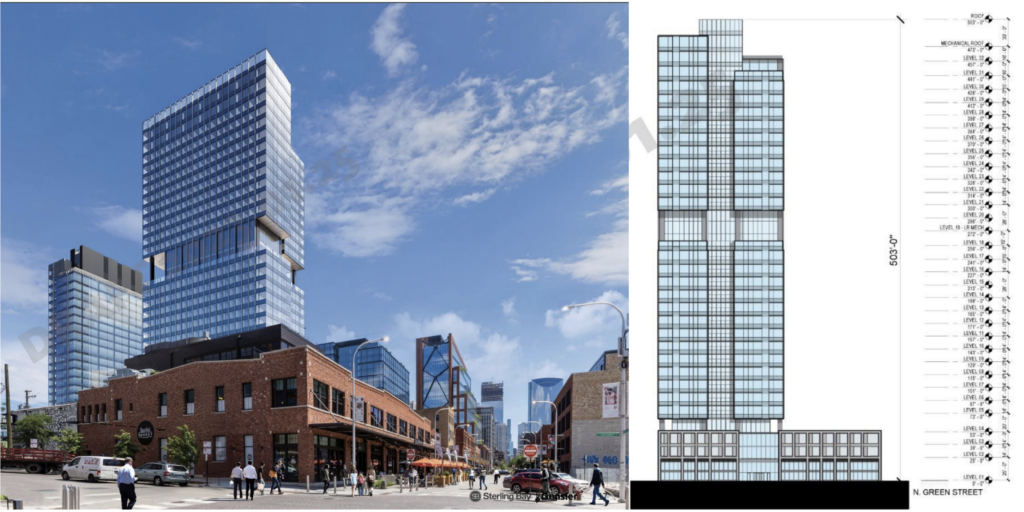
Rendering and elevation of 330 N Green by Gensler
Clad in a blue tint curtain wall with vertical fins running the full height of the structure, the new building will rise above the nearly completed The Row nearby. At the moment Sterling Bay has not announced any potential tenants for the 683,000 square feet of office space it will deliver if it builds the tower, but it is in the process of gaining all the necessary approvals to proceed once it does land a company to do so. It is worth noting that although the Sterling Bay website has not updated its renderings, it now shows a 2025 delivery date.
Subscribe to YIMBY’s daily e-mail
Follow YIMBYgram for real-time photo updates
Like YIMBY on Facebook
Follow YIMBY’s Twitter for the latest in YIMBYnews

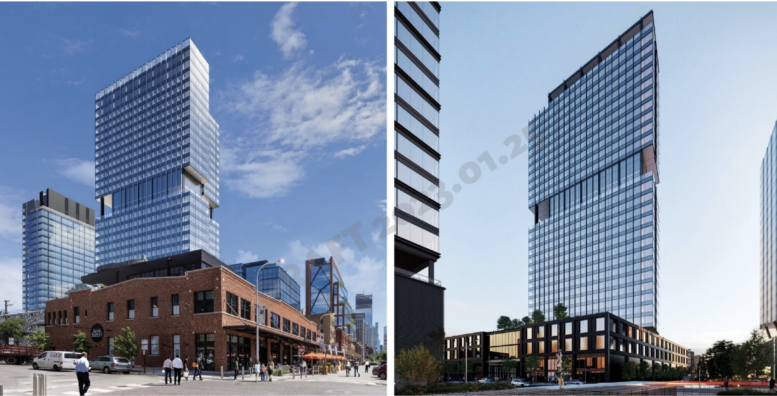
Upgrade. Build it.
Yes build immediately
If you’re gonna build a giant podium. At least make a light court out of it like they did here. Build.
Another monstrosity of a garage .
Absolutely no reason the 207 unneeded parking spaces cannot be put in an underground garage .
Agreed, and with its location, absolutely no reason to even have 207 parking spaces. We build all of this parking making it easy for rich people to drive everywhere and then we wonder why Chicago has the highest congestion index of any city in the country. It’s not rocket science.
Agreee however —- it’s not the developer’s fault tho it’s the city’s fault. Until the city gets seriously about improving and expanding the CTA the way NYC does with the MTA, people can only drive in here. Once Lasalle gets more residential that may change as the walkability of the greater area improves, but for now, if you don’t have a parking spot, you ain’t gettin in there. So many people in the marketing and tech industries still live in the suburbs and commute in every day. We need the city to build better infrastructure first, developers cannot take up the public realm’s work for them. We can influence this when we vote for mayors and add pressure to their campaigns.
If you are stuck with a job out in an exurban office park wasteland, no amount of mass transit is going to get you there. But even then you might be able to make that work – in many cases a Metra ticket and Uber ride every day would probably about equal to the cost of gas, insurance and maintenance to own a car. Plus, you get to sit on the train and catch up on your reading and sleep instead of drive the same route over and over (and over).
I have a car, but I get all over town on trains AND busses. So there is a network if you want to use it. I guess a lot of people feel the bus just won’t do. And for late at night, Uber costs are a lot less than the cost of owning a car.
But it could be a lot better, it is clear that the system is starved of funds.
I would love to see more extensions of the existing train lines (like the red line extension to the south), some new cross town trains to link the existing El into a network (Paris.London is a better example of a network that NYC, IMO), and light rail lines (bus rapid transit is a crummy consolation prize). I seem to remember, however, that one of the reasons cited the Olympics did not happen here was the state of mass transit. I think hosting the Olympics is in the long run a financial disaster for the host city, who is left with a lot of unused and decaying sports venues.
All that aside, parking podiums are still vile. The city should move from enabling car parking but allowing podiums to tolerating car parking by mandating underground parking.
Yes the CTA is starved of funds, as is the MTA in NYC. Other countries seem to make up for this by having national funds to constantly improve public transit, because they see it *at least* as equal to funding roads and highways. We don’t in the US. Chicago and NYC will never generate enough tax revenue alone to fund and vastly expand their public transit. What is needed is a vast reduction in highway funding and airports that goes towards everything else. I don’t see that happening any time soon, but it’s probably the only way.
Very true, thank god Fulton Market isn’t even close to turning into an exurban office park. It still has a great urban vibe and some of the best retail in the geographic region. It just needs a major public transit overhaul and it’s not Sterling Bay’s or any developer’s job to do it, until America makes it legal for public/private partnerships in transit like Japan does. It’s the state and city’s job. It’s good and I love that you live your life in such an urban manner but for many people they need more of a motivator, especially if they have young kids. I lived in Shanghai, Hong Kong, and Tokyo so I am very very familiar with excellent public transit. Forget it we’ll never get that.
Our system isn’t super safe at night — if you do hella overtime you would wanna drive back home going west. We have a shortage of drivers atm so the Blue Line comes every 35 minutes.
You cannot Uber home every night. I worked with executives who would do that and their significant others would constantly chastise them for wasting money on Uber that could be used on the kids. Especially if everyone starts doing that, the surge charges go up, especially on a rainy day. They have kids so they need to own a bigger car to shuttle the kids around anyway — this isn’t Tokyo you cannot let the kids ride the bus alone.
A core problem is that in many cities, and Chicago included, the transit boss is just a vanity position — mayors traditionally just give it to their friends so our public transit system literally hasn’t had a legit manager in generations. We really, really, need to fix that and create a political culture of pride in public transit
Wait what!? If we were talking about something like Back of the Yards or Irving Park neighborhoods, I’d agree with you. But West Loop!? It’s one of the most transit-served neighborhoods in the country from within the city and all of the suburbs. If this doesn’t cut it, what exactly are you envisioning?
West Loop went from zero to hero in like 7 years. It was literally a hellscape and then bloomed overnight. There’s no way in hell Chicago or Illinois government would have been that proactive. Sucks and I agree it’s a huge mistake, but to make this development pencil out with the dollars, developers are gonna need to create at least some parking to get it done. I would prefer they put it all underground and I think they are lying when they say it’s too expensive, but at least here they made a courtyard out of it and used the walls of the garage to a design advantage. Not ideal, but I mean they can’t build their own rail line….yet
West Loop went from zero to hero in like 7 years. It was literally a hellscape and then bloomed overnight. There’s no way in hell Chicago or Illinois government would have been that proactive. Sucks and I agree it’s a huge mistake, but to make this development pencil out with the dollars, developers are gonna need to create at least some parking to get it done. I would prefer they put it all underground and I think they are lying when they say it’s too expensive, but at least here they made a courtyard out of it and used the walls of the garage to a design advantage. Not ideal, but I mean they can’t build their own rail line….yet
Yeah, this site is a five minute walk from the Morgan Green/Pink Line station, a six minute walk from the Grand Blue Line station and less than a 15 minute walk from Ogilvie. This is not a location where you can only drive.
The new design is a vast improvement over the old one, which was impressive in the worng way – to make a building that size look like a stubby fire hydrant was quite a feat.
Would’ve loved to see a taller version of The Porch with 2 setbacks, keeping the design theme. Lots of potential. This design is fine, though uninspired. Looks similar to the BCG tower going up over on Green.
Better than it was – sometimes you have to just declare victory and move on.
This podium seems to be built for conversion to non parking uses in the future. Maybe it is just my imagination, but it seems like a lot of the new podiums could be retrofitted with level floors in case we really do manage to create a transit system that can convince people out of their cars. But I can’t really believe the real estate industry encourages long-term thinking.
I believe there is usually some consideration of future conversion even when parking podiums are built today. So that’s the good news 🙂
That is good news indeed, I certainly hope this is almost standard. Because otherwise we’re going to have a lot of ugly buildings at the bottom that serve no active purpose to the betterment of our beloved city.
I think the lowest-friction solution to West Loop transit problems is to build a branch of the Red Line that goes south from North Cloybourn to Goose Island (new stop), to the Chicago Blue stop, then south to the Morgan Green / Pink stop. Eventually could extend it further south to connect to Forest Park Blue branch, Metra BNSF at Halsted, Orange Line, and then reconnect back to Red.
Would be a way better use of funds than the south Red Line extension. In addition to the new branch, the city could build thousands of new CHA units by the new Goose Island stop to replace Altgeld Gardens.
While I’m assuming the obnoxious last sentence of the above post is a failed attempt at humor, and I’m not going to get into a discussion about whether or not it would be a “better” use of funds to build an extension of the Red Line on Near North Side vs. Far South Side, the southern Red Line extension has great potential to improve the lives of the people who live there, provide a much needed transit boost to an area that needs it, and have a huge positive impact in West Pullman and Roseland. Even if it isn’t something I’m likely to use.
I wish people would shut up about parking and automobile commuting already. High rent office space will always need parking guaranteed, outside of a few select areas in the country. People will continue to live in the suburbs and areas where cars are needed, especially people who work in high rent office space or live in expensive apartments. I get your point, but honestly Chicago will never not have a large portion of the population commuting via car, at least not in our lifetimes or our grandchildren’s lifetimes. It simply will not and it’s waste of everyone’s time to keep spamming the message boards with it. Suggesting everyone Uber as an alternative shows how out of touch these arguments truly are. Also, most everyone I know who lives downtown based their decision off of parking. The lack of parking is a significant downside for someone comparing high value apartments and condos. I commuted by train whenever I could in my life, but that didn’t mean I was about to give up my car.
I agree. It’s idiotic denial-ism. Firstly, zoning codes mandate parking requirements (though these should downsized), and secondly, a certain number of building users need parking – whether workers or visitors. To assume everyone will hop on the EL, bus, Uber, etc. in Chicago, to travel to work in the city center is a pipe dream. Not everyone lives with easy access to this, as the public transportation network doesn’t have the coverage of NY, London, Shanghai, etc.,… but those cities also provide parking for their office projects. Do you believe that upper management, C-level, etc., will hop on the 6 train, the Red/Blue/Green line, or Metra to travel to their office? Whether they live in the city or the suburbs, doesn’t matter. Some may, but until we’ve reached peak personal auto ownership, or have an encompassing mass transport system – parking will be in a project’s program. Acknowledging that, it should still be properly designed – meaning below grade. It is more expensive, but there are projects that do this and still make their pro formas pencil out.
George is there anything you do like?? How about sunshine in the month of January?